Chrysanthemum Tea Market Research, 2032
The global chrysanthemum tea market was valued at $153.1 million in 2022, and is projected to reach $249.8 million by 2032, growing at a CAGR of 5.1% from 2023 to 2032.
Chrysanthemum tea is a delicately hued, translucent yellow beverage derived through the infusion of dried chrysanthemum flowers in boiled water. This infusion known as a tisane, denotes an herbal elixir which results from the steeping of botanical components of chrysanthemum plant such as leaves, stems, and blossoms in hot water. Diverging from the conventional black or green tea varieties, chrysanthemum tea distinguishes itself by its absence of caffeine, setting it apart from other caffeinated counterparts. Positioned within the herbal tea category, it offers a caffeine-free substitute characterized by the unique flavor profile derived from the chrysanthemum flowers. This tea has gained recognition for its affiliation with a spectrum of health advantages, which consists of heightened immune reactivity, mitigated inflammation, and diminished blood pressure levels.
MARKET DYNAMICS
Surge in demand for beverages infused with floral flavors has had a significant impact on the Chrysanthemum Tea Market Growth These beverages provide a unique flavor experience that appeals to consumers who seek novel taste in their tea. Chrysanthemum tea, with its distinctive floral notes, effectively meets this demand and thus serves as an ideal alternative to conventional beverages available in the market. The visual appeal of floral-infused drinks, characterized by vibrant hues and delicate flower petals, enhances their aesthetic allure, and contributes to their popularity among consumers who value presentation in tea drinks. In addition, rise in preference toward floral-infused beverages presents substantial opportunities for market players in the chrysanthemum tea industry to cater to diverse consumer demands, capitalize on the natural & botanical trends, and attract a broader customer base, particularly health-conscious individuals. The key players may focus more on this trend and thus offer high-quality floral-infused beverages, which may help businesses to tap into the burgeoning market and differentiate themselves in the competitive market.
However, limited awareness and familiarity with chrysanthemum tea present significant barriers to the market growth. Moreover, lack of consumer knowledge in regard to the benefits and uses of the product hampers its widespread acceptance. Furthermore, cultural differences play a significant role in hindering the market growth for chrysanthemum tea.
In specific European cultural contexts, particularly within Western and Southern Europe, the chrysanthemum flower holds a profound association with the themes of death and mourning. It serves as a prevalent emblem of commemoration and prominently features within funeral arrangements and burial grounds. This cultural perspective is notably pronounced in nations such as France, Italy, Spain, and Belgium, where the presence of chrysanthemums elicits sentiments of bereavement and grief. For instance, during observances like All Saints' Day and All Souls' Day, individuals pay visits to the resting places of their dear departed and embellish them with flowers, with chrysanthemums being among the most frequently utilized species. Consequently, chrysanthemums have become intrinsically intertwined with funeral conventions and observances, acting as a psychological impediment for certain individuals when contemplating chrysanthemum tea as a beverage preference. However, in contrast, the availability of an array of distinct and premium tea varieties, encompassing chrysanthemum tea and other blends incorporating floral and herbal elements, tailored to accommodate the assorted inclinations of consumers, is anticipated to present lucrative prospects for the expansion of the global market throughout the projected timeframe.
Furthermore, upsurge in demand for authentic and high-quality tea experiences is anticipated to open new avenues for the market growth in terms of Chrysanthemum Tea Market Size. In addition, increase in emphasis on health-conscious lifestyle has fueled the popularity of specialty teas, as they often boast natural ingredients and potential health benefits. The specialty tea market presents beverage companies with a plethora of opportunities as they can differentiate their offerings by the launch of distinct flavors and blends, which targets specific segments of tea enthusiasts. This allows them to have control over premium pricing and establish themselves as leaders in the premium tea segment. Collaborations with tea artisans offer a chance to leverage their expertise and craftsmanship, which further results in the creation of exceptional tea combinations that captivate a large customer base. Moreover, packaging innovation is a key trend in the market, as eye-catching packaging designs contribute to the overall appeal of specialty teas and attract consumers who appreciate the artistry and sophistication of the product. Thus, these factors may present growth opportunities to increase the Chrysanthemum Tea Market Share during the forecasted period.
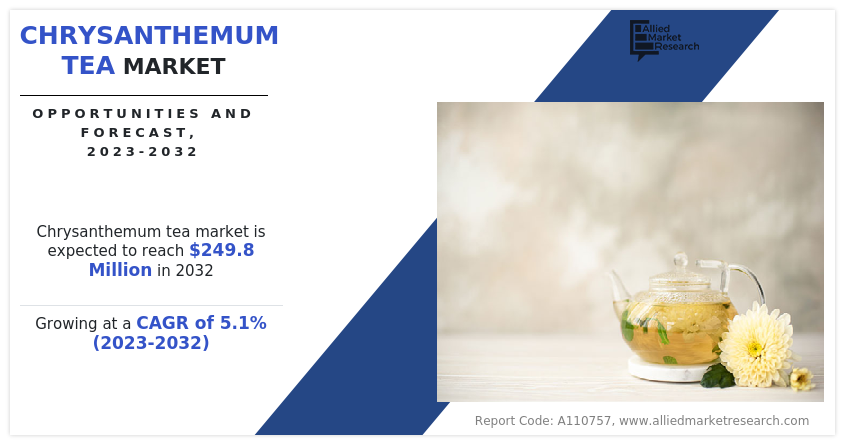
Segmental Overview
The global chrysanthemum tea market is segmented into type, packaging, application, distribution channel, and region. On the basis of type, the market is segregated into chrysanthemum indicum and chrysanthemum morifolium. As per packaging, it is divided into loose tea, tea bags, and bottled/canned. According to application, it is bifurcated into residential and commercial. On the basis of distribution channel, it is categorized into online and offline. Region wise, it is analyzed across North America (the U.S., Canada, and Mexico), Europe (the UK, Germany, France, Italy, Spain, Russia, and the rest of Europe), Asia-Pacific (China, Japan, India, South Korea, Australia, and rest of Asia-Pacific), and LAMEA (Brazil, South Africa, Saudi Arabia, Egypt, and rest of LAMEA).
By Type
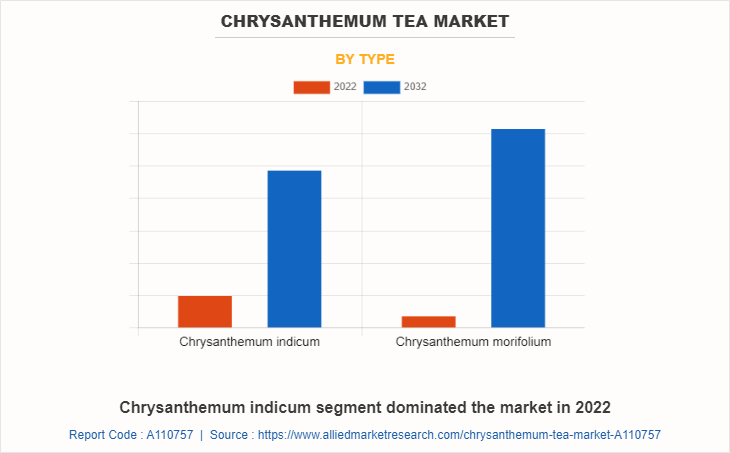
On the basis of type, the chrysanthemum indicum segment dominated the market, garnering a share of 52.1% in 2022. The observed phenomenon can be attributed to the considerable upswing in the demand for Chrysanthemum indicum tea. This surge is propelled by its perceived positive impact on health, deep-rooted cultural importance, and inherent herbal attributes. The Chrysanthemum indicum tea presents an exclusive aromatic and taste profile, enhanced with beta-carotene, vitamins, and flavonoids, all acknowledged for their positive impact on overall well-being.This tea variant, Chrysanthemum indicum, has garnered recognition for its purported antioxidative and anti-inflammatory attributes, which carry the promise of enhancing liver health, promoting digestive efficiency, and mitigating respiratory unease. It has been deeply ingrained in traditional Chinese medicine and tea culture for centuries, with its consumption during significant occasions, which symbolize relaxation and holistic wellness. As the demand for natural remedies continues to grow, chrysanthemum indicum tea has gained preference among individuals who value plant-based beverages and seek potential health advantages within their wellness routines.
By Packaging
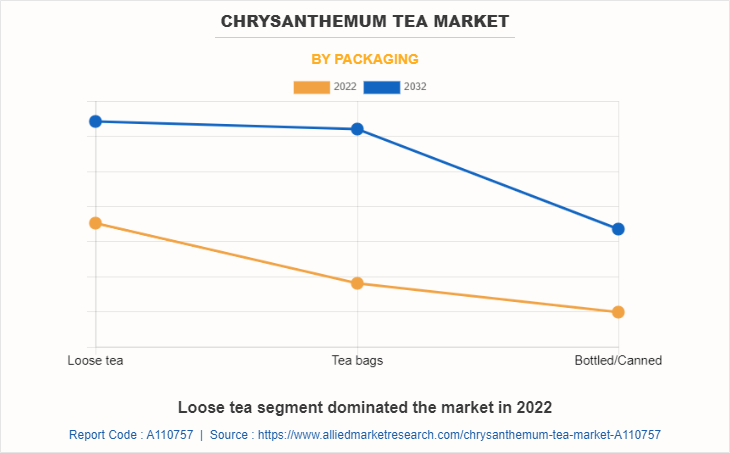
On the basis of packaging, the loose tea segment was the major shareholder in 2022, garnering a share of 42.7%. The customization and control provided by loose tea leaves allow individuals to tailor their brew to personal preferences and equally serve those who prefer a premium tea drinking experience. The extensive variety of tea types and specialty blends available in the loose leaf form further drives consumer demand during Chrysanthemum Tea Market Forecast, which caters to the desire for exploration and unique flavor experiences among consumers. In addition, the sustainability and eco-friendliness associated with loose tea leaves resonate with environmentally conscious consumers, as it does not produce any packaging waste. Loose tea presents a fully natural and compostable option and represents notably an eco-friendlier alternative. The production of loose tea leaves, which generally requires fewer resources, thus helps to reduce the associated carbon footprint during the whole process of manufacturing. These factors collectively fuel the demand for loose tea leaves and position them as a sought-after product in the competitive tea market.
By Application
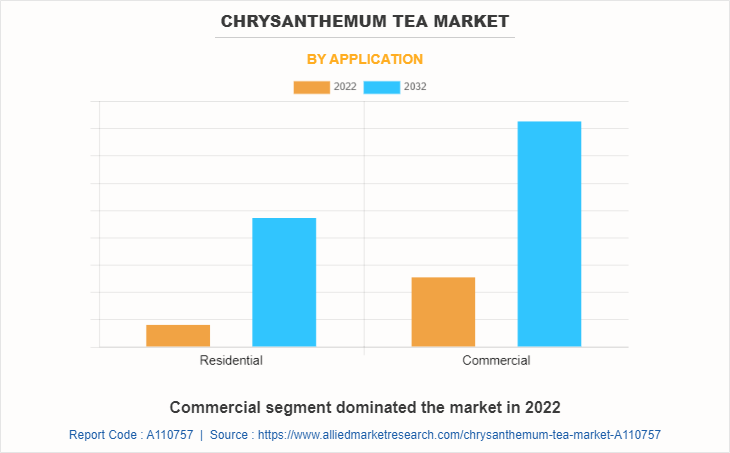
Depending on application, the commercial segment was the leading share contributor in 2022, accounting for a share of 55.6%. Chrysanthemum tea, extracted from chrysanthemum flowers, is witnessing high demand from various industries. Within the food & beverage sector, it serves as a versatile ingredient that enhances the taste profiles of a wide range of products, which includes ice creams, desserts, and alcoholic beverages. Furthermore, its association with traditional Chinese medicine positions chrysanthemum tea as a valuable element in herbal remedies and health supplements, which aligns with the growing demand for natural and holistic solutions. Due to its recognized cooling properties and perceived health benefits, it has gained significant popularity among health-conscious consumers who prefer natural herbal remedies over complex medical alternatives in the market. In addition, the skincare and cosmetics industry may leverage the antioxidant properties of tea to develop high-quality products such as facial cleansers, toners, moisturizers, and face masks. In addition, its pleasant aroma makes it an ideal ingredient for premium aromatherapy products, including scented candles, essential oils, and diffusers, which may create a relaxing and wellness-oriented ambiance for consumers. These factors collectively contribute to the potential growth of Chrysanthemum Tea Market Demand in the commercial segment.
By Distribution Channel
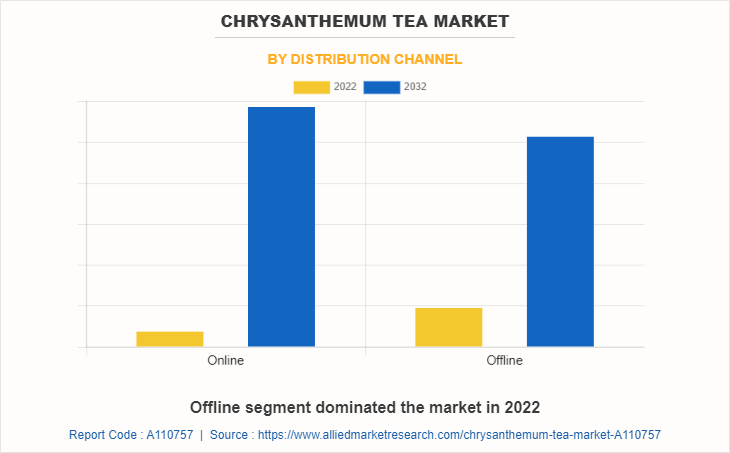
By distribution channel, the offline segment acquired the maximum share of 51.9% in 2022. The preference for in-person product selection, especially in the tea industry, where customers can assess the aroma and quality of tea leaves, has led to a rise in specialty tea shops and traditional herbal medicine shops operating in offline mode. These specialized outlets cater to the specific needs of customers, as they offer personalized and knowledgeable shopping experiences driven by frequent purchases and sales of particular products. Moreover, the availability of products through offline sales channels ensures prompt access to chrysanthemum tea, which eliminates the need for lengthy delivery times. Furthermore, these channels play a crucial role in serving local communities and meeting cultural preferences, particularly in regions where chrysanthemum tea holds traditional significance, such as Asian countries. As a result, these factors collectively contribute to the projected growth of this segment during the forecast period.
By Region
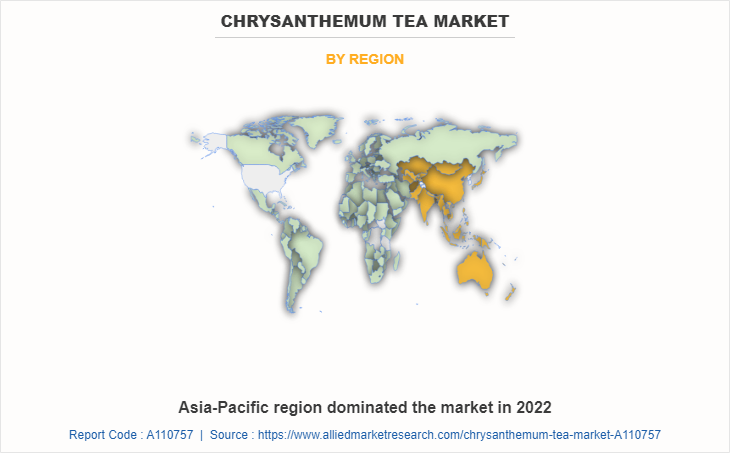
Region wise, Asia-Pacific dominated the market, garnering a share of 39.8% in 2022. This dominance is chiefly attributed to the integral role that chrysanthemum tea plays in the daily routines of millions of consumers across key countries including China, Korea, Singapore, and Japan. Renowned for its efficacy in cooling the body and providing respite from the sweltering summer conditions, chrysanthemum tea has emerged as a favored revitalizing beverage. Beyond its refreshing attributes, the tea boasts a rich heritage of traditional health benefits rooted in the annals of Chinese traditional medicine. These time-honored health advantages, recognized over centuries, have been harnessed in diverse herbal remedies. The proliferation of chrysanthemum flowers throughout the Asia-Pacific region, with China, Japan, and India leading the abundance, empowers major industry players to adeptly fulfill consumer demands with enhanced efficiency and cost-effectiveness. The intimate familiarity of consumers in this geographic expanse with the virtues of chrysanthemum tea bolsters its enduring consumption and augments its projected market growth in the years ahead. In parallel, the LAMEA region is poised to emerge as the second-largest market for chrysanthemum tea. This phenomenon is ascribed to a notable surge in chrysanthemum tea consumption, propelled by escalating health consciousness and the ascendancy of floral-infused beverages as a burgeoning trend. Additionally, the proliferation of internet accessibility has empowered consumers to explore a wider array of tea offerings, fostering an appetite for the distinctiveness of various tea varieties. The presence of substantial expatriate communities from East Asian nations within diverse LAMEA countries has catalyzed the introduction and proliferation of chrysanthemum tea within local markets and specialty tea emporiums. The cosmopolitan nature of the LAMEA region, coupled with its penchant for embracing global influences, has engendered a fertile ground for embracing diverse cultural practices, including tea consumption. Furthermore, the unique flavors and cultural significance associated with chrysanthemum tea have captured international interest, fueling heightened consumption within the LAMEA region..
Competition Landscape
Yunnan Sourcing Tea Shop, Bravo Tea, Asha Tea House, Teasenz, The Chinese Tea Company, Ten Ren Tea, Grand Tea & Imports, Onyx Coffee Lab, Chymey Teas, and Yeo Hiap Seng Ltd. are the major companies profiled in the chrysanthemum tea market report. These key players are constantly engaged in various developmental strategies such as partnerships, mergers, and acquisitions to gain a competitive edge and exploit the prevailing opportunities.
Key Benefits For Stakeholders
- This report provides a quantitative analysis of the market segments, current trends, estimations, and dynamics of the chrysanthemum tea market analysis from 2022 to 2032 to identify the prevailing chrysanthemum tea market opportunities.
- The market research is offered along with information related to key drivers, restraints, and opportunities.
- Porter's five forces analysis highlights the potency of buyers and suppliers to enable stakeholders make profit-oriented business decisions and strengthen their supplier-buyer network.
- In-depth analysis of the chrysanthemum tea market segmentation assists to determine the prevailing market opportunities.
- Major countries in each region are mapped according to their revenue contribution to the global market.
- Market player positioning facilitates benchmarking and provides a clear understanding of the present position of the market players.
- The report includes the analysis of the regional as well as global chrysanthemum tea market trends, key players, market segments, application areas, and market growth strategies.
Chrysanthemum Tea Market Report Highlights
| Aspects | Details |
| Market Size By 2032 | USD 249.8 million |
| Growth Rate | CAGR of 5.1% |
| Forecast period | 2022 - 2032 |
| Report Pages | 250 |
| By Type |
|
| By Packaging |
|
| By Application |
|
| By Distribution Channel |
|
| By Region |
|
| Key Market Players | Bravo Tea, The Chinese Tea Company, Asha Tea House, Teasenz, Yunnan Sourcing Tea Shop, Grand Tea & Imports, Onyx Coffee Lab, Ten Ren Tea Inc., Chymey Teas, Yeo Hiap Seng Ltd. |
Analyst Review
This section provides the opinions of top-level CXOs in the chrysanthemum tea market. Based on the evaluations conducted on top-level executives, the global chrysanthemum tea market stands poised for considerable expansion in the foreseeable future. This growth trajectory is underpinned by several drivers, including a heightened emphasis on health and wellness, a surge in demand for specialized tea varieties, the inherent advantages offered by chrysanthemum tea products, and a pronounced upswing in consumption across emerging markets.
Moreover, the propulsion of the chrysanthemum tea market can be attributed to technological advancements and a sustained drive for product innovation. This momentum is further bolstered by strategic geographical expansion, the strategic utilization of e-commerce and online sales platforms, and the integration of sustainability initiatives into business practices.
Top executives have notably underscored that preeminent players in the chrysanthemum tea market are presented with a substantial opportunity to capitalize on these prevailing trends. This can be achieved through diversification of their product range, strategic targeting of unexplored markets, and resource allocation towards research and development. By doing so, these market leaders can effectively create pioneering tea offerings that cater adeptly to evolving consumer preferences.
Despite challenges including heightened price-based competition and intricacies within the supply chain, the chrysanthemum tea market is anticipated to sustain its growth trajectory. This resilience can be attributed to its expansive consumer base in the Asia-Pacific region and its dexterity in adapting to evolving market dynamics.
The global chrysanthemum tea market was valued at $153.1 million in 2022, and is projected to reach $249.8 million by 2032
The global Chrysanthemum Tea market is projected to grow at a compound annual growth rate of 5.1% from 2023 to 2032
Yunnan Sourcing Tea Shop, Bravo Tea, Asha Tea House, Teasenz, The Chinese Tea Company, Ten Ren Tea, Grand Tea & Imports, Onyx Coffee Lab, Chymey Teas, and Yeo Hiap Seng Ltd. are the major companies profiled in the chrysanthemum tea market report. These key players are constantly engaged in various developmental strategies such as partnerships, mergers, and acquisitions to gain a competitive edge and exploit the prevailing opportunities.
Region wise, Asia-Pacific dominated the market
Rise in demand for floral-infused beverages, Health benefits associated with tea, Product innovation and diversification
Loading Table Of Content...
Loading Research Methodology...



